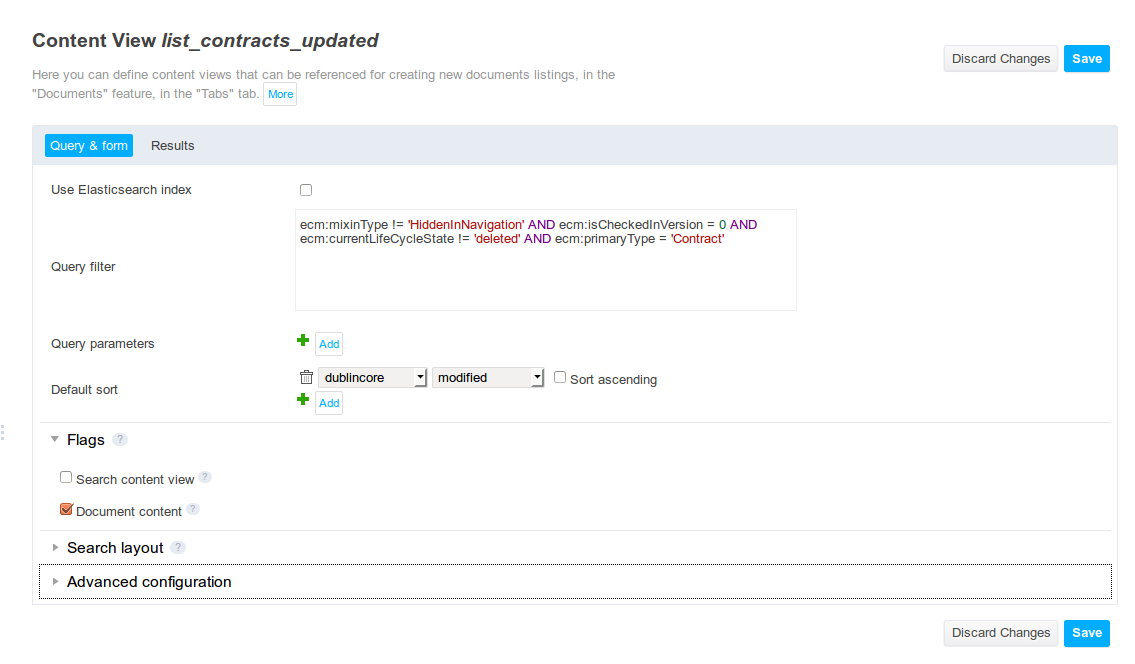Adding a New Entry in the Default Dashboard
Goal: Displaying the list of documents of type Contract recently updated (assuming you already defined documents of type Contract).
Creating the Content View
Let's create a content view that will get all the documents of type Contract that have been recently updated.
- In Nuxeo Studio, create a new content view and name it
list_contracts_updated. - In the Query & form tab, define the request to get all the documents of type Contract and order them by modification date.


- In the Results tab, configure the display of the results of the query, with the following columns:
- The icon of the document
- The title with a link
- The date of the last modification
- The name of the last contributor


In the Advanced configuration section, check that the following properties are not selected:
- Show CSV export
- Show PDF export
- Show syndication links
- Set the property
Titleto define the element title that is going to be displayed on the dashboard.
Adding the Content View in the Dashboard
Now that the custom content view is created, the next step is to contribute to the service defining the list of elements in the dashboard.
Create a new XML extension named dashboardContracts. It has to contribute to the following extension points:
- widgets: the widget used by the new entry is a widget of type
contentViewWithForms. In the properties, it must reference the name of the content view that you created in the first step. You can also configure some properties to customize the behavior (hide the widget if the content is empty, or define it foldable, etc...) - actions: a new entry in the Dashboard is actually an action. The action references the widget of the new entry, it is the widget that was just defined above. There are two important attributes to define:
- category: this will make this action an element of the dashboard. The dashboard defines two categories
DASHBOARD_LEFTandDASHBOARD_RIGHT.DASHBOARD_LEFTis to put the element on the left column of the dashboard andDASHBOARD_RIGHTto put it on the right one. - order: order is used to set the order of the elements in the dashboard column.
- category: this will make this action an element of the dashboard. The dashboard defines two categories
<extension target="org.nuxeo.ecm.platform.forms.layout.WebLayoutManager" point="widgets">
<widget name="dashboard_contracts" type="contentViewWithForms">
<properties widgetMode="any">
<property name="contentViewName">list_contracts_updated</property>
<property name="foldable">true</property>
<property name="hideEmpty">false</property>
<property name="useAjaxPagination">true</property>
</properties>
</widget>
</extension>
<extension target="org.nuxeo.ecm.platform.actions.ActionService" point="actions">
<action id="dashboard_contracts" type="widget" order="10">
<category>DASHBOARD_LEFT</category>
<properties>
<property name="widgetName">dashboard_contracts</property>
</properties>
</action>
</extension>
Deploying the Project
Deploy your Studio project on your Nuxeo Platform and go to the home page.


Overriding the Default Dashboard
In this how-to, let's go deeper in the customization of the dashboard: let's replace the default dashboard by a custom one.
Getting the Extension to Override
The extension defining the link Dashboard and the content of the tab is org.nuxeo.ecm.user.center.dashboard.jsf.actions:
<extension target="org.nuxeo.ecm.platform.actions.ActionService"
point="actions">
<action id="Dashboard" link="/user_center_fragment.xhtml" label="user.center.dashboard" icon="/icons/dashboard.png" order="10">
<category>USER_CENTER</category>
</action>
<action id="DashboardMain" link="/incl/dashboard/user_jsf_dashboard.xhtml" label="" order="10"
type="admin_rest_document_link">
<category>Dashboard_sub_tab</category>
</action>
</extension>
You need to override this contribution in order to define your custom dashboard instead.
Creating the New Tab in Studio
For this example, create a tab displaying a content view listing the document of type Contract, ordered by modification date.
- In Studio, create a new tab.
- To display the list of documents of type Contract, add a widget Content view and select the content view
list_contracts_updated.

- In the Activation tab, select only the document type Nothing for the parameter Current document has one of the types.
The purpose is to let Studio create the corresponding tab, but make sure that it's not displayed by default as you'll display it with custom XML code below.


Overriding the Default Dashboard
As viewed in the first step, the part you will need to override is:
<extension target="org.nuxeo.ecm.platform.actions.ActionService"
point="actions">
<action id="DashboardMain" link="/incl/dashboard/user_jsf_dashboard.xhtml" label="" order="10"
type="admin_rest_document_link">
<category>Dashboard_sub_tab</category>
</action>
</extension>
- In Studio, create a new XML Extensions.
Copy the contribution above but replace the value of the parameter
linkwith the name of the generated XHTML by Studio. The name of the file will be/studio_tabs/studio_tab_XXX.xhtml, XXX is the name of the tab, so in our case/studio_tabs/studio_tab_NewDashboard.xhtml.<extension target="org.nuxeo.ecm.platform.actions.ActionService" point="actions"> <action id="DashboardMain" link="/studio_tabs/studio_tab_NewDashboard.xhtml" label="" order="10" type="admin_rest_document_link"> <category>Dashboard_sub_tab</category> </action> </extension>
Deploying the Project
Deploy your Studio project on your Nuxeo Platform and go to the home page.

